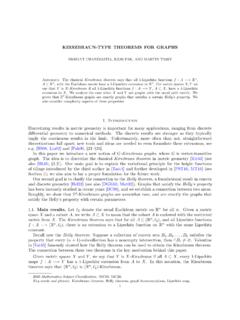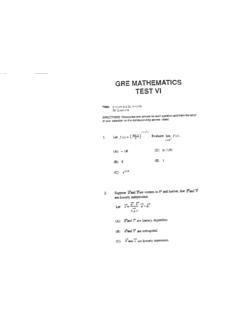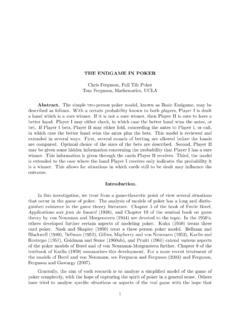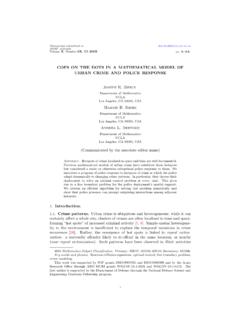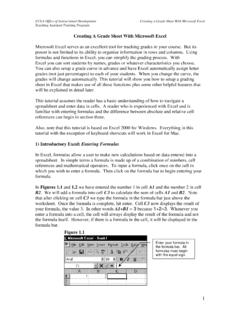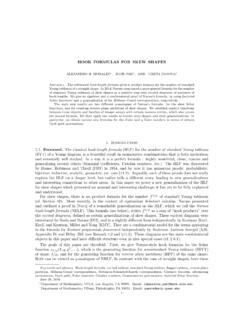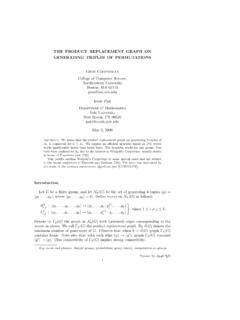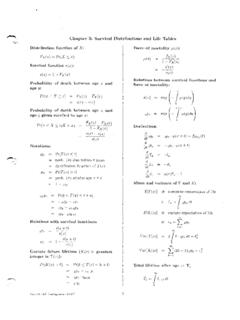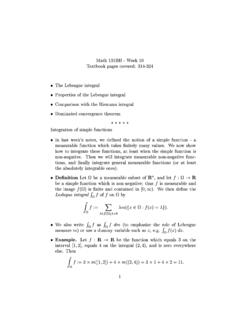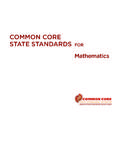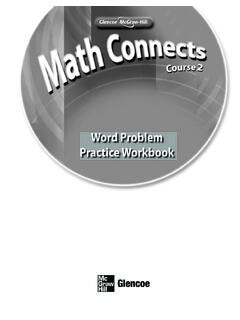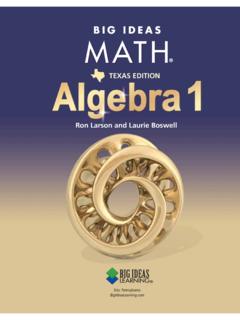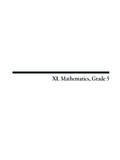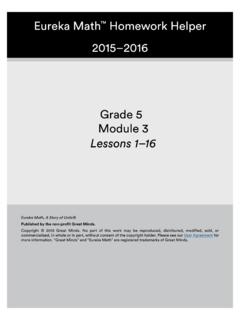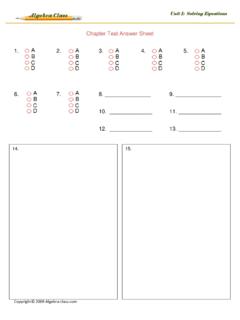Transcription of Math 3C Homework 3 Solutions - UCLA
1 math 3C Homework 3 SolutionsIlhwan Jo and Akemi Problems 2, 7, 8, 9, 11, 13, 15, 18, 21, 22, 29, 31, draw three cards from a standard deck of 52 cards. Find the probability that the third card is a clubgiven that the first two cards were the event that the third card is a club and letBthe event that the first two cards were the probability that all three cards are clubs isP(A B) =(133)(523),and the probability of the first two cards being clubs isP(B) =(132)(522).So the conditional probability that the third card is a club given that the first two were clubs isP(A|B) =P(A B)P(B)=(133)(523)(132)(522)= way of doing this problem is noticing that the probability of the first card being a club is1352andthe probability of the second card being a club is1251.
2 As 2 clubs have already been removed from thedeck, there are only 11 clubs left out of the 50 remaining cards. So the probability that the third card isa club given that the two we already removed are clubs roll two fair dice. Find the probability that the first die is a 4 given that the sum is the event that the first die shows 4 andBdenote the event that the sum of the dice is that for any number the first die shows, there is only one number the second die can show to makethe sum 7 ( if the first die shows 5 then the second die must show 2 to make the sum 7). So there area total of 6 ways to make the sum of the two dice equal 7 soP(B) = , if the first die shows 4 there is only one way to make the sum of both dice equal 7 which meansP(A B) = , the probability that the first die shows 4 given that the sum is 7 isP(A|B) =P(A B)P(B)=1/366/36= roll two fair dice.
3 Find the probability that the first die is a 5 given that the minimum of the twonumbers is the event that the first die shows 5 andBdenote the event that the minimum of both diceis 3. If the minimum of both dice is 3, then at least one of the two dice must be 3 and both must begreater than or equal to 3. SoP(B) = probability that the first die shows 5 and the second shows 3 isP(A B) = the probability that the first die is 5 given that the minimum of both dice is 3 isP(A|B) =1/367/36= toss a fair coin three times. Find the probability that the first coin is heads given that at least onehead the event that the first coin is heads andBbe the event that at least one head occurred.
4 ThismeansBcis the event that no heads occur which happens with probability18. So we getP(B) = 1 P(Bc) = 1 18= the first coin is a head, then the other two flips can be either heads or tails to satisfy the requirementthat at least one head occurred. Given that we know thatP(A B) = the probability that the first coin is a heads given that at least one head occurred isP(A|B) =P(A B)P(B)=4/87/8= screening test for a disease shows a positive test result in 90% of all cases when the disease is actuallypresent and in 15% of all cases when it is not. Assume that the prevalence of the disease is 1 in 100. If thetest is administered to a randomly chosen individual, what is the probability that the result is negative?
5 SolutionOne way of solving this problem is to find the probability that the result is positive then subtracting thatfrom 1. LetAbe the event that the result is negative soAcis the probability that the result is letB1be the event that the person is infected andB2be the event that the person is not the law of total probability we know that the probability that the result is positive isP(Ac) =P(Ac|B1)P(B1) +P(Ac|B2)P(B2). From the given information, we know thatP(B1) = 1/100,P(B2) = 99/100,P(Ac|B1) = andP(Ac|B2) = SoP(Ac) = (1/100) + (99/100) = the event that the test result is negative and we can calculate that byP(A) = 1 P(Ac) = 1 = other way of solving this problem is to directly calculate the probability the result is the same definitions ofA, B1, B2as above, we can use the law of total probability to getP(A) =P(A|B1)P(B1) +P(A|B2)P(B2).
6 ThenP(B1) = 1/100 andP(B2) = 99/100. Now the probability that the test is negative given that theperson is infected isP(A|B1) = 1 = Similarly the probability that the result is negative if theperson is not infected isP(A|B2) = 1 = SoP(A) = (1/100) + (99/100) = drawer contains three bags numbered 1-3. Bag 1 contains two blue balls, bag 2 contains 2 green balls,and bag 3 contains one blue and one green ball. You choose one bag at random and take out one the probability that the ball is the event that we choose a blue ball and letBibe the event that bagiis chosen (that is,B1isthe event that we choose bag 1,B2is the event that we choose bag 2 andB3is the event that we choosebag 3).
7 Using the law of total probability we see thatP(A) =P(A|B1)P(B1) +P(A|B2)P(B2) +P(A|B3)P(B3).Since each bag is equally likely of being chosen,P(Bi) =13fori= 1,2,3. If we choose bag 1, then theprobability of getting a blue ball is 1 and if we choose bag 2 the probability of getting a blue ball is 0. Butif we choose bag 3, there is one of each color ball so the probability of getting the blue ball is12. Therefore,we getP(A) = (1)13+ (0)13+(12)(13)=13+16= pick two cards from a standard deck of 52 cards. Find the probability that the second card is an this to the probability that the first card is an the event that the second card is an ace,B1be the event that the first card is an ace andB2bethe event that the first card is not an ace.
8 Since theBipartition the sample space, we can use the law oftotal probability to getP(A) =P(A|B1)P(B1) +P(A|B2)P(B2).The probability of the first card being an ace is452=113so the probability of the first card not being anace is 1 113=1213. If the first card was an ace, then there are only 3 aces left out of the 51 cards soP(A|B1) =351=117. Otherwise, if the first card was not an ace, there are still 4 aces left soP(A|B2) = we haveP(A) =(117)(113)+(451)(1213)= that we said the probability of the first card being an ace wasP(B1) =451=113so the probabilityof the second card being an ace is the same as the probability of the first card being an that you have a batch of red- and white-flowering pea plants where all three genotypesCC, Cc,andccare equally represented.
9 You pick one plant at random and cross it with a white-flowering peaplant. What is the probability that the offspring will have red flowers?SolutionLetAbe the event that the offspring has red flowers,B1the event that you pick a plant of genotypeCC,B2the event that you pick a plant of genotypeCc, andB3the event that you pick a plant of genotypecc. Since they are equally represented,P(Bi) =13. Using the law of total probability,P(A) =P(A|B1)P(B1) +P(A|B2)P(B2) +P(A|B3)P(B3).SinceP(A|B1) = 1, P(A|B2) =12, P(A|B3) = 0,P(A) = 1 13+12 13+ 0 13= are dealt on card from a standard deck of 52 cards. IfAdenotes the event that the card is a spadeand ifBdenotes the event that the card is an ace, determine whetherAandBare (A) =14andP(B) =113.
10 The probabilityP(A B) that the card is the spade ace is152. HenceP(A B) =152=P(A)P(B)andAandBare are dealt two cards from a standard deck of 52 cards. IfAdenotes the event that the first card is anace andBdenotes the event that the second card is an ace, determine whetherAandBare problem15, we know thatP(A) =P(B) =113. The probabilityP(A B) that the two cards areaces is(42)(522)=4 352 51=113 17. HenceP(A B)6=P(A)P(B)andAandBare not that the probability that an insect species lives more than five days is Find the probabilitythat in a sample of size 10 of the this species at least one insect will still be alive after 5 probability that an insect lives more than five days is independent of the other insects.
